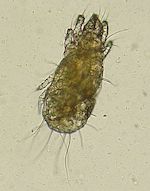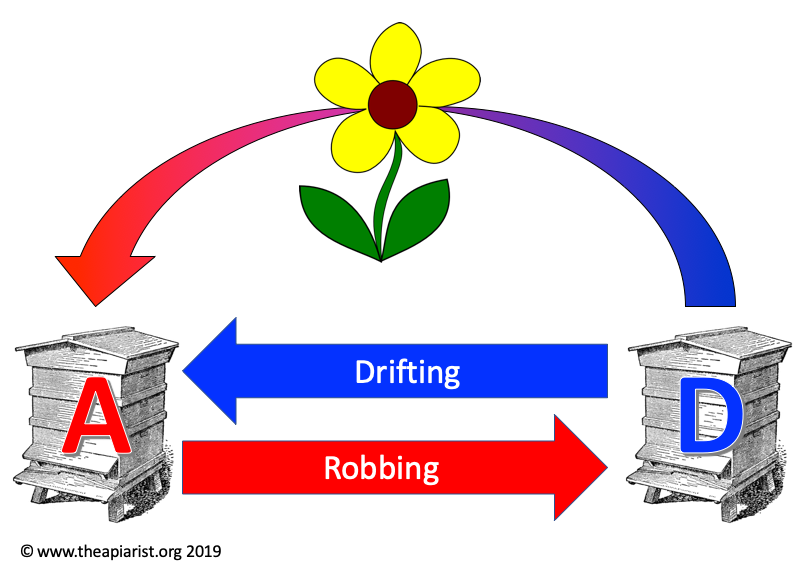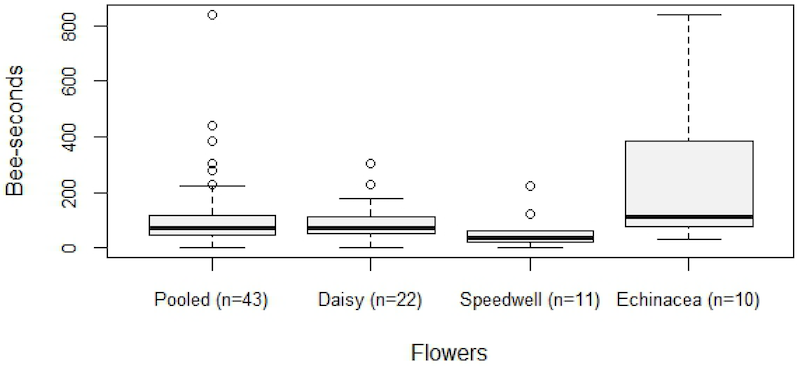Flower mites
Where do all those pesky mites come from that transmit pathogenic viruses in and between colonies?
Unless you are fortunate enough to live in the remote north west of Scotland {{1}} or the Isle of Man then bees, whether managed or feral, in your area have the parasitic mite Varroa destructor.
And if you take a mite-free colony from, say, north west Scotland and stick it in a field in Shropshire {{2}} it will, sooner or later, become mite-infested.
Sooner rather than later.
In our studies we see mite infestation (capped drone pupae with associated mites) within a few days of moving mite-free colonies to out apiaries.
Where did these mites originate and how did they get there?
Direct or indirect? Active or passive?
They don’t walk there.
Mites are blind and have no directional abilities over long distances.
Essentially therefore there are just two routes, both involving the host honey bee {{3}}.
Direct, in which phoretic mites are transferred on honey bees between colonies, or indirect, in which they are transferred via something that isn’t a bee in the environment.
Like a flower.
With an infested hive (the Donor) and a mite-free hive (the Acceptor {{4}}) the direct routes involve the well-established processes of drifting and robbing.
As far as the acceptor hive is concerned, drifting is a passive process. The bees just arrive at the entrance and are allowed access.
In contrast, robbing is an active process by the acceptor hive. The foragers that rampage around pillaging weak colonies bring the phoretic mites back with them.
There have been two recent papers that have considered the relative importance of these routes and, in the case of indirect transmission, whether there is evidence that it can occur.
Both papers are from Thomas Seeley and colleagues at Cornell University. Seeley conducts simple and elegant experiments and, apart perhaps for the statistics, both papers are pretty readable, even without a scientific background.
I’ll deal with indirect transmission here and return to drifting and robbing in the future.
Say it with flowers … send her a mite
There is quite a bit of circumstantial evidence that horizontal transmission via flowers may occur. This includes evidence that mites can survive on flowers for several days (in the absence of bees). If ‘presented’ with live or dead bees these mites could then climb onto the bee.
But clambering aboard a dead bee held in a pair of tweezers is very different from boarding a live bee making a transient visit to a flower.
Like this.
This short video is by David Peck, the lead author on a 2016 manuscript on acquisition of mites by bees visiting flowers {{5}}. The paper is open access and freely available so I’ll cut to the chase and just present the key details.
The mites and bees came from the same colony. Mites were harvested by sugar roll and placed on flower petals. Different flower species were baited with the same anise-flavoured sugar solution to make them equally attractive to foraging bees.
Video recording of bee visits enabled the scientists to determine whether the mite attached to a bee, if it was subsequently groomed off (in the vicinity of the flower) and how long any interaction took. The latter was measured in bee seconds i.e. the cumulative number of seconds a bee was present before the mite attached.
In 43 independent tests, using a total of three different flower species, every mite successfully managed to clamber onto a visiting bee. Of these, 41 left the flower with the bee (the two that didn’t fell off or were groomed by the bee).
Speed and efficiency
It took on average just two minutes of bee visits for the mite to climb aboard. In one test the mite successfully attached in just 2 seconds.
About 50% of the mites attached after the first contact with a bee. The average number of contacts needed was just over two (usually to the same bee).
We’ve all watched bees visiting flowers. They approach, orientate, land, take off again, reorientate, land again. Sometimes they walk across the inflorescence.
That’s all it takes.
The mites didn’t move about the flower much. They didn’t chase the bee around the flower. None moved more than 1 cm.
They simply waited for the bee to come close enough.
Mites haven’t got eyes but they have exquisitely sensitive chemosensory receptors on their forelegs (not four legs, they have eight 😉 ). They use these to detect the approaching bee and are then nimble enough to embark, as the video above shows.
Mites on daisy (Bellis sp.) or speedwell (Veronica sp.) relocated to a bee much more rapidly than those placed on an Echinacea flower. It’s not clear why – the flowers are larger on Echinacea so perhaps it’s something to do with the way a bee interacts with these when foraging?
Case proven m’lud?
Mites are transferred between colonies via flowers … it’s a fact.
Not quite.
What this study shows was that mites on flowers can readily attach to a visiting bee.
Specifically to a visiting bee from the same hive that the mite was ‘harvested’ from for the experiments.
Mites absorb the cuticular hydrocarbon profile of their host hive i.e. they smell like the bees do. Perhaps they were less readily detected by the visiting mite-free bee? Would they transfer to bees from a foreign colony less efficiently?
Conversely, host-parasite theory would suggest that the mite would have evolved mechanisms to preferentially infest ‘foreign’ visiting bees {{6}}. At least they should if this route provided a suitable selective pressure, which would involve it providing an advantage to the mite (over other routes like robbing or drifting, for example). This remains to be tested.
But there’s something else missing until we can be certain that mites are transferred indirectly between colonies via flowers.
Have you ever seen a flower with a mite on it?
I haven’t either.
Which of course doesn’t help support or refute a role for flowers in mite transmission.
Absence of evidence is not evidence of absence.
A limited survey of flowers around apiaries also failed to detect Varroa {{7}} which is as little help as our own observations (see above).
So we’re left with half a story. Mites can transfer (quite efficiently) from flowers to bees. What we don’t know is whether – or how – they get from infested bees to the flower in the first place.
And if they do, whether it happens frequently enough to be of any real relevance as a mite transmission route between hives.
Next week I’ll revisit robbing and drifting as mite transmission routes to discuss some recent studies looking at their relative importance.
One last thing … one of the co-authors of the 2016 study described above is Michael L. Smith. In 2014 he published the honey bee sting pain index. I’m pleased to see he’s moved on to less painful scientific studies 🙂
Colophon

Flour mite (c) Joel Mills
The flour mite (Acarus siro), a distant relative of Varroa destructor, is a contaminant of grain and – unsurprisingly – flour which “acquires a sickly sweet smell and becomes unpalatable”.
Which isn’t a huge recommendation for Mimolette cheese. This cheese originates from Lille in France. It has a grey crust and an orange(ish) flesh, looking a bit like a cantaloupe. The crust hardens over time.
The appearance, the hardening (?) and certainly the flavour of the crust is due to the addition of flour mites (aka cheese mites) which are intentionally introduced during production of the cheese. Yummy.
{{1}}: Or the islands such as Colonsay.
{{2}}: No offence meant to readers from Shropshire … I could have chosen any county in England or Wales.
{{3}}: Hold that thought … I’ll return to this next week.
{{4}}: Which could just as well be a hive with very low mite levels, but ‘mite-free’ is easier to write.
{{5}}: Peck DT, Smith ML, Seeley TD (2016) Varroa destructor Mites Can Nimbly Climb from Flowers onto Foraging Honey Bees. PLoS ONE 11(12): e0167798. https://doi.org/10.1371/journal.pone.0167798.
{{6}}: These could come from mite-free hives and/or offer an opportunity for increasing mite genetic diversity.
{{7}}: Pettis JS, Ochoa R Orr J. Interception of a live Varroa mite on imported cut flowers in the United States. Int J Acarology. 2003;29:291–292.


Join the discussion ...